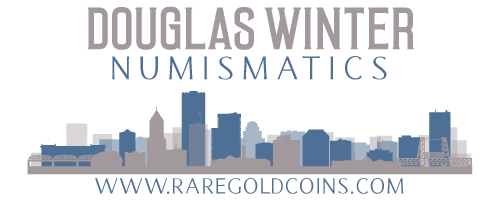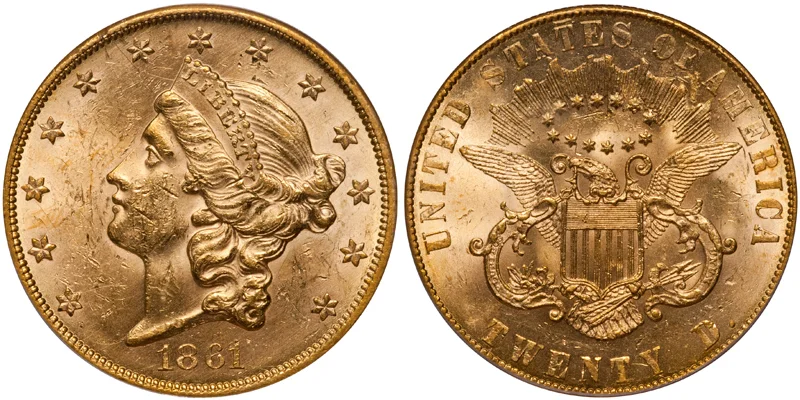If you are a collector of San Francisco gold coins, there are a few buying tips I’d like to offer. These range from pretty basic to pretty savvy, and they can be applied (in some cases) to other series if San Francisco coins are not your particular cup of chai.
1. Don’t Pay Shipwreck Prices for non-Shipwreck Coins
It is an established fact in the market that coins from the major shipwrecks are worth a premium over non-shipwreck coins. This is especially true for S.S. Central America coins with low shipwreck populations. But this information can be misinterpreted and can cause a collector to overpay. Let me give you an example.
Recently, I was offered a decent quality AU58 1855-S double eagle by another dealer. As part of his sales pitch, he mentioned that an example had recently sold for $7,931; thus his coin, priced at $7,500, seemed like a good deal. What he conveniently failed to mention to me was that this auction price was for a coin pedigreed to the S.S. Central America and that the last non-SSCA coin had brought $5,288. Once I mentioned this, his reaction was a simple “oh…I forgot to mention that, huh?”
When you are figuring prices for S mint coins, especially Type One double eagles, the sales records for shipwreck coins have little bearing on non-shipwreck coins and vice versa.
2. Don’t Pay Full Shipwreck Prices for Re-Packaged Coins
The premiums that shipwreck coins sell for are packaging-dependent. In other words, an AU58 1855-S double eagle from the S.S. Central America is worth more (quite a bit more in fact) if it is in an original PCGS gold-foil holder than in an NGC holder. Why? Because in this instance, the coins from the SSCA were originally graded by PCGS, and collectors want them in their original packaging.
Another example: in 2013, three PCGS/CAC MS66 1857-S double eagles in their original gold-foil holders were sold at auction, and they brought $32,900, $32,900, and $33,030. Two NGC MS66 examples sold this year and they realized $17,625. Why? Because the market clearly realizes that these coins were formerly PCGS MS65’s and because they are no longer in their original holders.
3. Premium Quality San Francisco CAC Coins Can Be Worth Significant Premiums
As I have previously discussed, many San Francisco issues do not come nice, and it is likely that their CAC populations will be very low. Let me give you two quick examples.
The 1862-S half eagle is a very scarce date in all grades and it is seldom found choice and original. PCGS has graded 39, and CAC shows a current population of just two coins; an EF40 and an EF45. Now granted that many 1862-S half eagles in PCGS holders have not been sent to CAC, but the fact two only two have been approved (and none above EF45) indicates that this is an issue that is not seen with a nice, natural appearance.
As another example, let’s look at the 1862-S eagle; a date which is nearly as rare as its half eagle counterpart. PCGS has graded 45 examples and CAC shows a current population of just two: an EF45 and an AU55. Again, not all the PCGS coins have been sent to CAC, but my feeling is that the percentage of 1862-S eagles (and half eagles) with CAC approval will remain very small; probably less than 10% of the coins graded.
It seems to me that CAC approved examples of the 1862-S half eagle and eagle should be worth a fairly significant premium above their non-CAC counterparts.
4. How Do You Price Very Rare Date San Francisco Gold?
When it comes to rare/very rare San Francisco gold coinage, most published price guides are of little to no use. Auction prices are far more relevant, and this is how I price such coins. So how do you price a coin in, say, EF45 when the last auction record was in 2008?
Here are some of the factors that I take into consideration when pricing San Francisco gold. First, is the coin fundamentally rare? In the case of the aforementioned 1862-S half eagle and eagle, these are issues which are rare in all grades. Secondly, how nice is the coin which is being offered to me? Is it abraded, not terribly original and softly struck, or is it relatively free of marks, original and well impressed for the issue? If it is the former, an older auction record might have some weight with my pricing. If it is the latter, I know I will have to stretch; maybe considerably.
5. The Two Distinct Groups of San Francisco Gold
As San Francisco gold becomes more popular, we are seeing a distinct bifurcation of the market: the coins made prior to 1879 which tend to be rare in all grades, and the coins made after 1879 which tend to be rare only in high (or very high grades).
I think we will continue to see quite a bit strength in the rarity-driven market as collectors tend to be more interested in coins like 1862-S half eagles in VF than in 1892-S half eagles grading MS64. The market for condition rarities will be more hit or miss. Certain coins, including many of the “top pops” from the Saddle Ridge Hoard, will be eagerly absorbed into collections. Others may prove far harder to sell.
6. Year Sets Will Become Popular
There were six different denominations of gold coinage produced at the San Francisco mint. There were just four years in which all six denominations were made, and one of these includes a unique issue (the 1870-S three dollar). This leaves collectors with three possible choices for six-coin year sets: 1856, 1857, and 1860.
None of these three years contains an impossible rarity, and the first two years could even be completed in Uncirculated grades. The 1860-S is the most difficult set as the half eagle and the eagle are both rare in all grades, and virtually impossible to find above AU55.
I don’t think these sets are The Next Big Thing in coin collecting, but I wouldn’t be surprised if a few savvy collectors attempted to complete at least one year.
7. Learn What Real Color Looks Like
There are numerous high-value San Francisco gold coins in both PCGS and NGC holders which have questionable color. I suggest you learn what original color looks like for the San Francisco issues which are of interest to you. Notice I didn’t suggest you learn how to grade; I think most of you taking the time to read this have other things to do with your few free minutes per day. But I do think it’s important to learn that, as an example, all 1862-S quarter eagles are supposed to have a certain shade of color, and if you see one which isn’t close to this shade, it’s likely been enhanced.
How do you learn what original coins look like? Look at catalogs with old time collections (Bass, Norweb, James Stack, and Eliasberg) and study the hues/patterns of color that these coins had. Go to the ANA Museum in Colorado Springs and study the Bass coins. Carefully study the raregoldcoins.com Coinapedia to see hundreds of pictures of unmolested, original coins.
8. Learn How to Differentiate Strike vs. Wear on Type One and Type Two Double Eagles
Many new collectors of San Francisco gold are thrown off by the difference between strike and wear on Type One and Type double eagles; two of the most popular series from this mint.
As you begin to learn about these coins, you will begin to determine that certain issues are always found with weakness on the hair or on the stars or even at the centers. Learn which issues are struck which way. This is reasonably easy to do as photo archives for higher grade San Francisco double eagles can be found on ha.com or on PCGS Coinfacts.
9. Best Value Grades
I have written before on Best Value Grades. As San Francisco gold coins become more popular and increase in value, I think this is an important point for collectors to consider.
10. Does Size Matter?
So far, the San Francisco gold coin renaissance has been led by large-size coins: eagles and double eagles. Will this increase in popularity carry over to smaller coins?
I can see gold dollars and three dollars from this mint becoming popular due to the possibility of these being collected by series, and the possibility of these sets being completed.
The quarter eagles from this mint I’m not as sure about. The fundamentals of these coins make sense to me. Other than the 1854-S, all the issues are obtainable and many can be purchased in Uncirculated grades for under $5,000. But with the exception of the Civil War issues, these coins have just not yet caught on with collectors.
The “wild card” series is the half eagles. These are already reasonably expensive coins and in the case of the Civil War rarities, and they are more expensive than most any southern branch mint half eagle while (currently) being far less popular. It is hard to call a moderately popular (but indisputably rare) issue like an 1862-S half eagle “undervalued” when it is already a pricey coin. But “value” is relative, especially in the rare date gold market and I think San Francisco half eagles—at least those struck prior to 1878—are destined to become very avidly collected in the next few years.
Do you buy rare gold coins?
Do you have coins to sell?
Would you like to have the world’s leading expert with you assembling a set of coins?
Contact me, Doug Winter, directly at (214) 675-9897 or by email at dwn@ont.com.

















